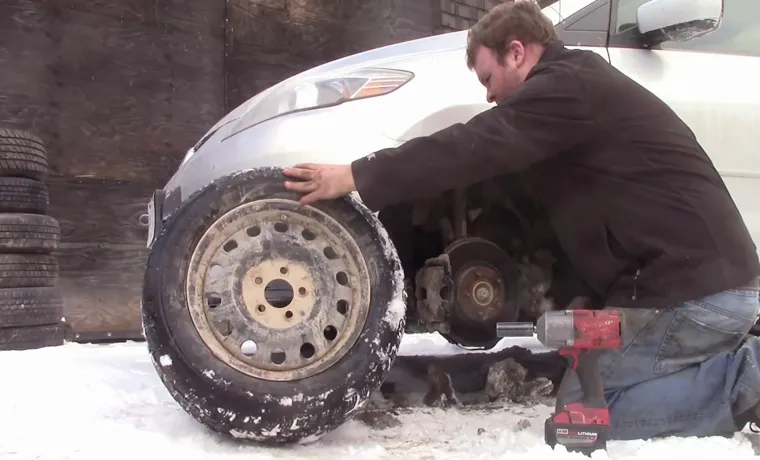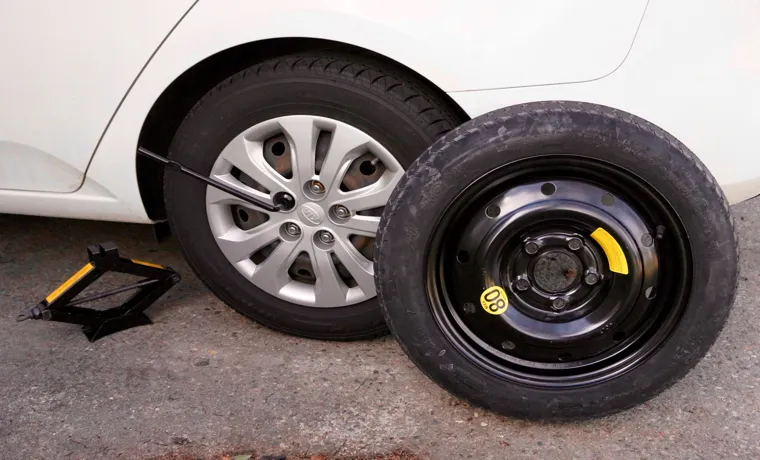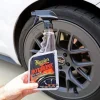Flat tires are every driver’s nightmare and can occur at the most inopportune times. Picture this: You’re driving along a serene road, jamming to your favorite tunes, and before you know it, your car starts to sway, the steering wheel feels heavy, and you hear a loud thump. It’s a flat tire, and it’s time to pull over.
Flat tires can be a major inconvenience, but they don’t have to ruin your day. Knowing what to do in such a situation can make a world of difference. In this blog post, you’ll learn what to do if you have a flat tire and how to stay safe while doing it.
So sit tight and keep reading!
Table of Contents
Assess The Situation
If you suddenly find yourself with a flat tire while driving, don’t panic. The first thing to do is assess the situation. Make sure you find a safe spot to pull over, away from traffic if possible.
Turn on your hazards to let other drivers know there’s an issue. Take a look at the tire and see if it’s completely flat or just low on air. If it’s completely flat, don’t attempt to drive on it as this could cause further damage to your car.
If you have a spare tire and the necessary tools, you can attempt to change the tire yourself. However, if you are uncomfortable or unsure about how to change the tire, it’s best to call for roadside assistance. They can safely replace your tire or tow your car to a nearby mechanic.
Remember to stay calm and stay safe on the road.
Don’t Panic
When faced with a stressful situation, it can be easy to let panic take over and cloud your judgment. That’s why the first step in any emergency is to take a deep breath and assess the situation. What’s going on? What’s the severity of the situation? Who’s involved and what resources do you have available? By breaking down the situation into manageable pieces, you can better understand what needs to be done and make a plan of action.
It’s important to stay calm and clear-headed so you can make the best decisions possible. Remember, even in the midst of chaos, there’s always a solution. So don’t panic; take a step back and assess the situation.

Pull Over To A Safe Area
Assessing the situation is paramount when you find yourself in a situation where you need to pull over to a safe area. It is crucial to identify the type of issue you are dealing with. You may experience a flat tire, engine trouble, or a transmission failure, for example.
Once you know what you are dealing with, you can determine which is the safest area to pull over and address the issue. Always be mindful of the area around you, look for a place where you will not be a hazard to other traffic, and where you can safely exit your car. Hazard lights should also be turned on immediately to alert other drivers of your situation and proceed at a reduced speed to minimize the risk of impact.
Remember, staying calm, assessing the situation, and reacting promptly can make all the difference when you need to pull over to a safe area.
Check Your Spare Tire
When was the last time you checked your spare tire? It might not be something you think about every day, but it’s crucial to assess the condition of your spare tire before you hit the road. You don’t want to be stuck on the side of the road with a flat tire and a spare that’s no good. Firstly, check the tire’s air pressure and ensure it’s not underinflated or overinflated.
Over time, the air in the tire can leak out, reducing the pressure to unsafe levels. Secondly, check the tread of the tire, and make sure it’s not worn out. If the tread is damaged or has worn down, you could be jeopardizing your safety.
Remember, the spare tire might make the difference between arriving at your destination on time or experiencing a delay. So, make sure you commit to regularly checking the condition of your spare tire to avoid any inconvenience or danger on the road.
Replace The Flat Tire
If you find yourself with a flat tire, it can be a frustrating and intimidating experience. However, there are steps you can take to quickly and safely replace the tire. First, find a safe location off the road where you can park your car and turn on your hazard lights.
Retrieve your spare tire, jack, and tire iron from your car’s trunk or storage compartment. Before you begin, make sure the spare tire is properly inflated. Then, use the tire iron to loosen the lug nuts on the flat tire.
Place the jack under the car’s frame and jack up the vehicle until the flat tire is completely off the ground. Next, remove the lug nuts and take off the flat tire. Place the spare tire on the car, hand tighten the lug nuts, and then lower the vehicle back down to the ground.
Finally, use the tire iron to tighten the lug nuts in a star pattern until they are secure. Don’t forget to check the spare tire’s pressure and get your flat tire repaired or replaced as soon as possible. Remember, with the proper tools and a bit of know-how, replacing a flat tire is a manageable task that anyone can handle.
Gather Necessary Tools
When it comes to replacing a flat tire, one of the first things you need to do is gather the necessary tools. The last thing you want is to be stranded on the side of the road without the proper equipment. You’ll need a spare tire, a lug wrench, and a jack.
It’s also a good idea to have a pair of gloves and a flashlight on hand. Before you begin, make sure your car is on a flat surface and safely away from traffic. Once you have all of your tools at the ready, you can start the process of replacing the tire.
Remember, safety always comes first, so take your time and don’t rush the job. With the right equipment and some patience, you’ll have your car back on the road in no time.
Loosen The Lug Nuts
Loosening the lug nuts is a crucial step when replacing a flat tire. Firstly, locate the jack and the spare tire. Place the jack under the designated area of the car, usually indicated by an arrow or instructions in the manual.
Start cranking the jack until it lifts the car off the ground, but be sure not to exceed the weight capacity of the jack. Use your lug wrench to loosen the nuts by turning them counterclockwise. Don’t take them all the way off just yet, as you’ll want to wait until the car is fully lifted.
Now, remove the lug nuts and carefully take off the flat tire. Replace it with the spare tire and put the lug nuts back on, tightening them by hand. Finally, lower the car back down to the ground and use the wrench to finish tightening the lug nuts.
Double-check that everything is secure, pack up your tools, and you’re good to go. Remember, if you’re unsure about anything, refer to your car’s manual or contact a professional. Stay safe on the road, and don’t forget to check your spare tire’s air pressure from time to time!
Jack Up The Car
When you have a flat tire, the first step to fixing it is to jack up the car. You will need a jack, lug wrench, spare tire, and your car manual. Start by finding a flat surface and turning on your hazard lights.
Locate the jacking points under your car, which are usually indicated by arrows or notches. Then, use the lug wrench to loosen all the lug nuts on the flat tire, but don’t remove them yet. Place the jack under the jacking point and pump it until the car is off the ground.
Make sure the jack is stable, and then remove the lug nuts and take off the flat tire. Replace it with the spare tire and hand-tighten the lug nuts. Lower the jack and tighten the lug nuts in a crisscross pattern.
Finally, check the tire pressure and refer to your car manual for any specific instructions. By following these steps, you can safely replace a flat tire and get back on the road in no time.
Remove The Flat Tire
When you find yourself with a flat tire, the first thing you need to do is remove it from the wheel hub. This can be done straightforwardly by following a few simple steps. The best way to start is to ensure that your car is on level ground and in a stable position.
You don’t want it rolling away while trying to change a tire! Make certain that the emergency brake is engaged before moving on. Next, you need to locate your spare tire and the tools required to replace the flat tire. Most cars come with a jack that is used to lift the car off the ground.
Place the jack in a secure position beneath the vehicle and begin to lift it up. Be sure to consult your owner’s manual for specific instructions. Once the car is lifted, remove the hubcap and use the lug wrench to loosen the nuts on the wheel you’re replacing.
Once they’ve been loosened, you can remove them by hand, making sure not to lose them. Then, carefully remove the flat tire and replace it with the spare tire. Finally, use the lug wrench to tighten the nuts on the new tire, lowering the vehicle and removing the jack.
Remember to drive carefully on your new tire and get the flat tire repaired or replaced as soon as possible. Taking care of your tires is essential for safety on the road, so don’t wait to replace a flat tire. Keep your car in good working order by making sure you have the tools and knowledge to change a tire if you need to!
Mount The Spare Tire
If you find yourself with a flat tire, don’t panic! It’s a common problem that can be easily solved. The first step is to locate the spare tire and the necessary tools in your vehicle. The spare tire is usually stored in the trunk or underneath the vehicle.
Once you have the spare tire and tools, use the lug wrench to loosen the lug nuts on the flat tire, but don’t remove them just yet. Next, use the jack to raise the vehicle off the ground where the flat tire is located. Once the car is in the air, remove the lug nuts and pull the flat tire off.
Take the spare tire and put it on the car, lining up the holes in the rim with the bolts. Tighten the lug nuts by hand, then use the lug wrench to securely tighten them. Finally, lower the car back to the ground and make sure all the lug nuts are tightened properly.
With these simple steps, you’ll be back on the road in no time. Remember, it’s always important to have a spare tire and the necessary tools in your vehicle in case of emergencies.
Tighten The Lug Nuts
When it comes to replacing a flat tire, there are a few essential steps you need to follow to get back on the road safely. One of these critical steps is tightening the lug nuts to ensure that your tire stays securely fastened to the wheel. To do this, you will need a lug wrench, which you can find in your car’s toolkit.
Once you’ve replaced your flat tire with the spare, use the lug wrench to tighten each lug nut in a star pattern. Start with one nut and move diagonally to the one across from it. Continue in this pattern until all the nuts are tight.
Be sure not to over-tighten the nuts, as this can cause the wheel to warp. As a general rule of thumb, use a torque wrench to tighten the lug nuts to the automaker’s recommended torque specification. By taking this precautionary step, you can ensure that your tire stays securely fastened to the wheel and prevent any mishaps or accidents while driving.
Get The Tire Repaired Or Replaced
“What to do if I have a flat tire” If you find yourself in the unfortunate situation of having a flat tire, there are a few things you can do to get back on the road. Firstly, ensure your safety by pulling over in a safe spot, such as a rest stop or the side of the road. Turn on your hazard lights and use a warning triangle or cones to alert other drivers.
Assess the tire and determine whether it can be repaired or needs to be replaced. If the puncture is less than ¼ inch in diameter and in the tread area, it can usually be repaired. However, if the sidewall is damaged or the puncture is too large, it will need to be replaced.
If it’s a simple puncture and you have a tire repair kit, you can attempt to repair it yourself. Alternatively, call for roadside assistance or use your spare tire to reach a tire repair shop. Remember to always drive with caution on a spare tire and get the damaged tire repaired or replaced as soon as possible.
Tire Repair Kit
If you’re out on the road and suddenly your tire goes flat, you may be wondering if you should repair the tire or replace it altogether. A tire repair kit can be a useful tool to temporarily fix the puncture, allowing you to continue driving until you can get to a professional tire repair shop. However, it’s important to understand that some tire punctures, such as those on the sidewall, cannot be repaired and must be replaced.
Additionally, if the tread depth is too low or the tire is too old, it may be safest to replace it completely. It’s always best to prioritize safety over a quick fix, so if you’re unsure about the severity of the puncture, it’s best to err on the side of caution and seek professional help. By properly maintaining and inspecting your tires regularly, you can avoid potential tire blowouts and ensure a smoother, safer ride on the road.
Tire Replacement
Tire Replacement If you’re facing tire problems, there’s a crucial question that most vehicle owners ponder: should you repair or replace the tire? Well, there’s no one-size-fits-all answer to this question since it depends upon the extent of the tire damage and the age of the tire itself. If there’s a tiny puncture or nail in the tire and it’s still relatively new, then a patch or plug repair might suffice. However, if the tire damage runs deep or the tire is ancient, it’s better to have it replaced altogether.
Keep in mind that operating with a worn-out tire on the road can be incredibly dangerous, leading to blowouts, accidents, or hydroplaning possibilities. Therefore, it’s essential to replace the tire as soon as you notice any severe tire damage or if the tire has worn out from normal wear and tear. Remember, your safety is the utmost priority, and neglecting tire replacement can cause severe consequences.
So, get your tire inspected today, and if needed, go for a replacement without any second thoughts.
In Conclusion
In the unfortunate event of a flat tire, remember to keep calm and stay safe. Following these simple steps: moving to a safe location, turning on your hazard lights, loosening the lug nuts, using a jack to lift the car, removing the tire, installing the spare tire, tightening the lug nuts, and double-checking the tire pressure; can have you back on the road in no time. Just remember, while you may not be able to control everything that happens on the road, you can always control how prepared you are for it.
So, stay sharp, know your way around a tire, and never let a little inconvenience deflate your spirit.”
FAQs
What are the signs of a flat tire?
The most common sign of a flat tire is a sudden drop in tire pressure. Other signs may include a vibrating steering wheel, pulling to one side while driving, or a visible puncture or tear in the tire.
How can I prevent a flat tire?
Regular maintenance and inspection of your tires can help prevent flat tires. Check the tire pressure regularly and keep it at the recommended level. Replace worn tires and make sure they are properly aligned. Avoid driving over potholes, sharp objects, or debris in the road.
What should I do if I have a flat tire while driving?
Safely pull over to the side of the road and turn on your hazard lights. Assess the damage to the tire. If it can be repaired, change it with a spare tire. If you do not have a spare or are unsure how to change a tire, call for roadside assistance.
Can a flat tire be repaired?
It depends on the extent of the damage. A puncture or small tear in the tire can often be repaired by a professional tire repair service. However, if the damage is too severe or on the sidewall of the tire, a replacement may be necessary.
How long can I drive on a flat tire?
It is not recommended to drive on a flat tire as it can damage the rim and cause more extensive damage to the tire. At most, you may be able to drive a short distance at a low speed to get to a safe location or nearby repair shop.
How do I change a flat tire?
First, consult your car manual for specific instructions. Then, use a jack to lift the car off the ground, remove the lug nuts, and take out the damaged tire. Replace it with the spare tire, tighten the lug nuts, and lower the car back to the ground.
How often should I check my tire pressure?
It is recommended to check your tire pressure at least once a month and before any long drives. Check the pressure when the tires are cold, before driving and after the car has been sitting for a few hours.



